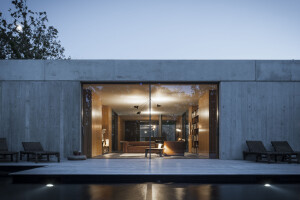The former orphanage to IJsbaanpad in South Amsterdam was built in 1959-1960 by Aldo van Eyck, and is the first example of structuralism.
Aldo van Eyck it gained much respect at home and abroad. The building is made up of 328 small units, four single-layer large units, four large units with a floor and a rectangular volume containing the entrance. The different units are grouped around several patios and a courtyard.
The small module measuring 3.36 x 3.36 meters and have four round columns at the corners and a rounded roof, where the span between columns is made by architraves. The facade consists of a glass wall or solid wall of brown brick. The domed roof elements are made of precast concrete, this caused a problem detailing at the lowest point of the roof. The large units have a length and width that is three times as large as that of the small units. The floors have a facade of precast concrete elements.
Van Eyck was guided by the motto: "a small world in a big, big world into a small house as a city, a city as a home, a home for children."
The orphanage to IJsbaanpad has been in use from 1960 to 1991. Previously, the Amsterdam Orphanage the building which is now the Amsterdam Museum (formerly the Amsterdam Historical Museum) is located. The building on the IJsbaanpad was extensively renovated in 1991 and has been in use for other destinations.
The name of the orphanage is to preserve this place as the street behind Burgerweeshuispad is known. The office complex located on this street Tripolis (1994) was also designed by Aldo van Eyck.


















